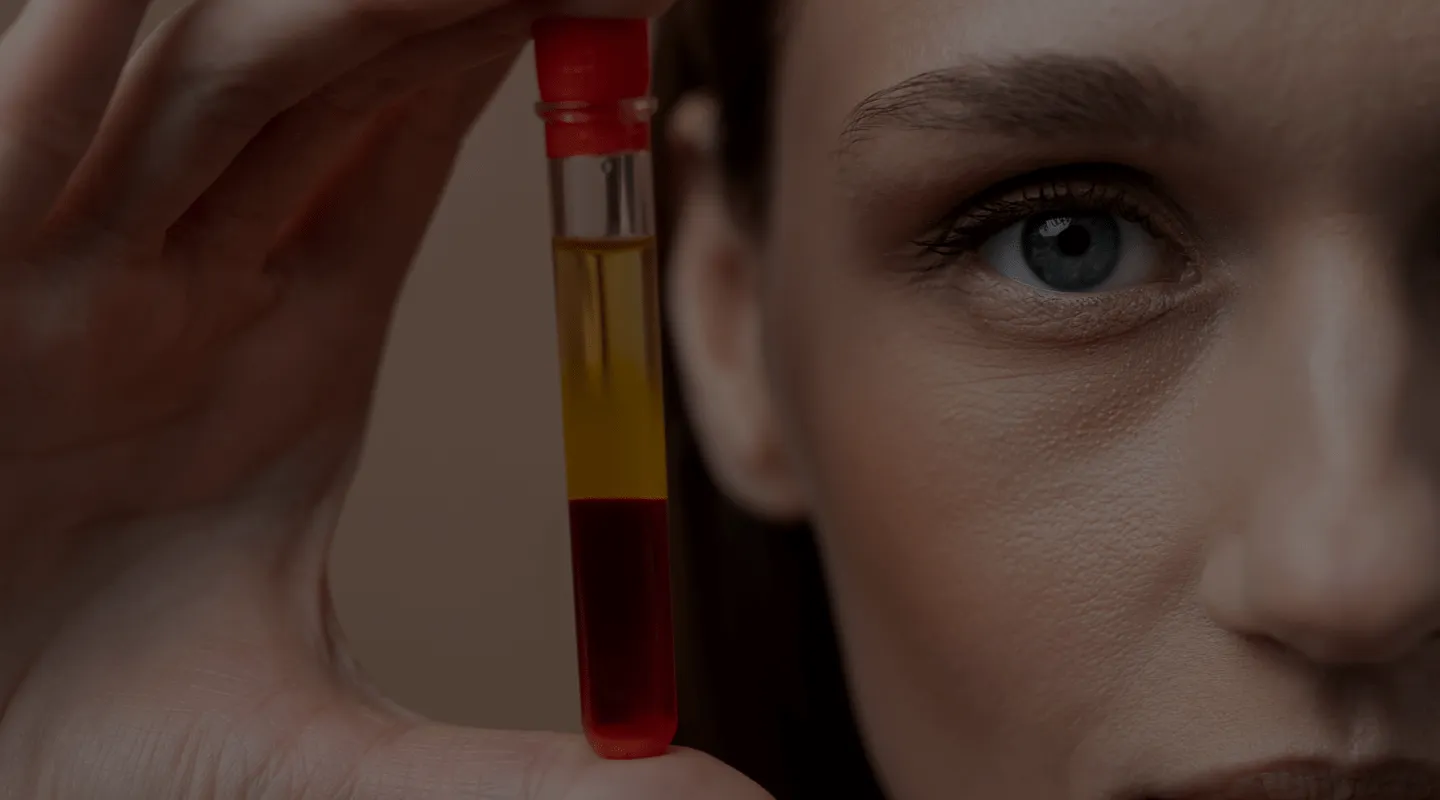
PRP Treatment
Your PRP Treatment in Tunisia at an Affordable Price
Naturally stimulate the regeneration of your skin and hair with PRP (Platelet-Rich Plasma) treatment
How does it work?
What is PRP, Platelet-Rich Plasma?
PRP is a concentrate of blood plasma that includes platelets, growth factors, leukocytes, and cytokines. The PRP treatment method has been gaining popularity in Europe, the United States, and the Far East for many years in various fields. Doctors use it to accelerate the healing of wounds, soft tissues, and hair loss.
PRP, an acronym for platelet-rich plasma, uses growth factors derived from the centrifugation of blood drawn from the same patient. This type of treatment based on blood components has been used for years to regenerate damaged tissues during maxillofacial surgery and, in the orthopedic field, in degenerative joint diseases. In aesthetic medicine, PRP helps fight skin aging and treat stretch marks and scars. Evidence that platelet-rich plasma could stimulate cell regeneration has driven research toward its use in the trichological field as well.
How does PRP work during a hair transplant?
The doctor applies the platelet-rich plasma by injection directly into the affected area using a regular insulin syringe. Only medical personnel perform the injections in order to comply with prophylaxis regulations and minimize the risk of infection. The treatment is not limited to a single application. Indeed, the doctor performs cycles of 3 or 4 sessions monthly. After each session, the patient can continue their normal daily routine.
Is PRP treatment painful?
You may experience some discomfort due to repeated injections into the scalp. Some operators are used to applying small doses of anesthetic to reduce the feeling of discomfort.
PRP Hair in Tunisia: Who is the therapy for?
PRP is a minimally invasive treatment indicated for patients who:
- Suffer from alopecia at an early stage;
- Have limited thinning of the hair;
PRP is therefore indicated to naturally stimulate hair regrowth, in particular, in cases of:
- Androgenetic alopecia;
- Alopecia areata;
Results: Is PRP for hair effective?
The effectiveness of PRP applied to the trichological field has been confirmed by several scientific publications. These studies affirm that the infiltrations have reduced hair loss and increased hair diameter. However, the treatment is still, in some respects, controversial. In general, PRP is a valid strategy to counter the hair loss process.
Note that not all people with alopecia benefit from PRP treatment. The possible and actual effects of the treatment should be discussed with the doctor during the preliminary examination. This therapy stimulates follicular regrowth and, although some variability from one subject to another must be taken into account, an increase in the number of new hairs per square centimeter has been observed. After the infiltrations, the PRP therefore begins to act by promoting hair regrowth, strengthening existing fibers, countering the miniaturization of follicles and improving their vitality.
Advantages of PRP treatment in Tunisia during a hair transplant
It is strongly recommended to perform a PRP during a hair transplant. Tunisia Destination Santé systematically offers all its patients a PRP performed during a hair transplant. Note that hair transplantation is an extremely safe, fast and risk-free process. However, circumstances may arise during the procedure which, if not avoided, could end up altering the good result of the hair transplant. All these hypothetical negative circumstances are avoided by using the PRP technique during the procedure, for example:
- PRP helps to avoid dehydration of the donated hair follicles, due to lack of moistening before extraction and during transplantation;
- The possible lack of nutrients and oxygenation of the hair follicle is also avoided thanks to PRP;
- Minor lesions caused by revascularization when the implanted follicle must adapt to the receiving area and return to receiving quality blood in the new position are mitigated by a platelet-rich treatment;
- The use of PRP in extracted follicles preserves them and prepares them for subsequent adaptation in the receiving area, thus ensuring adequate rooting;
What are the contraindications of PRP treatment in Tunisia?
There are no contraindications to PRP treatment because it comes from the patient’s own blood. In addition, as it is a blood sample, there is no risk of rejection. The doctor performs the treatment with autologous plasma, thus avoiding the risk of blood-borne diseases. In addition, PRP has no side effects such as allergies, intolerances or rejection.
PRP is performed in a sterile manner to ensure that the patient’s blood is not contaminated. As the lifespan of platelets is quite limited, the surgeon performs the different processes of this technique consecutively and in the shortest possible time (approximately 30 minutes). Thanks to ideal centrifugation conditions, platelets and growth factors do not suffer any trauma, allowing this innovative treatment to exert its regenerative action.
Resuming daily activities after PRP hair transplant in Tunisia
Return to normal daily activities is immediate, as there are no bruises or ecchymoses. Indeed, platelets prevent their appearance because they contribute to blood clotting. At the end of the treatment, the patient may notice slight redness, but it will disappear within a few hours. As a general rule, avoid applying cosmetics in the first few hours after treatment. Note that sun exposure is not recommended only if there are small bruises on the skin.
Take the step for a hair transplant and enjoy a free PRP in Tunisia
If, despite several PRPs, the expected result is not there and you are thinking of having a hair transplant, take the step and you will have a free PRP with a hair transplant using the FUE technique. The PRP will then allow you to revitalize your scalp.
Our advantages


Contact and request a quote for PRP in Tunisia or a hair transplant
If you are tempted to have a PRP or a hair transplant, do not hesitate to contact Tunisia Destination Santé. Our team is always at your disposal to assist and guide you through all the procedures. We accompany you step by step in order to build your file and organize your procedure. Feel free to contact us for more information and to request a free, no-obligation quote.
Your health, our priority.
Request your free quote.
Frequently Asked Questions
PRP was initially used in sports medicine to boost wound healing. Then, its potential for tissue regeneration led to its use in dermatology, including for treating hair loss.
No, PRP is generally more effective for people with moderate hair loss due to androgenetic alopecia. It may not be as effective for severe forms of hair loss or for autoimmune conditions such as alopecia areata.
PRP stimulates dormant hair follicles thanks to the growth factors contained in the platelets. Indeed, these growth factors improve blood circulation and promote cell regeneration, which can revitalize the follicles and encourage hair growth.
Generally, patients begin to see results after 3 to 6 months of treatment. However, results may vary depending on the individual response to treatment and the frequency of sessions.
A good candidate for hair PRP is generally a healthy person with moderate hair loss and realistic expectations. Moreover, people with blood disorders or chronic diseases may not be good candidates.
Generally, the side effects of PRP are minor and may include pain at the injection site, headaches, and bruising. The risks of allergic reactions are minimal because the doctor prepares the PRP from the patient’s own blood.
PRP is less invasive than hair transplantation and does not have the systemic side effects of medications such as finasteride. However, it may not be as effective as these treatments for some people.
Yes, PRP can be combined with other treatments such as minoxidil, finasteride, and even hair transplants to improve overall results.
No, PRP is not a permanent treatment. The effects can last from several months to a few years, and regular maintenance sessions are often necessary to maintain the results.
Follow-up protocols may include additional PRP sessions every 3 to 6 months, as well as appropriate hair care such as the use of gentle shampoos and avoidance of harsh hair treatments to maximize the benefits of PRP.
